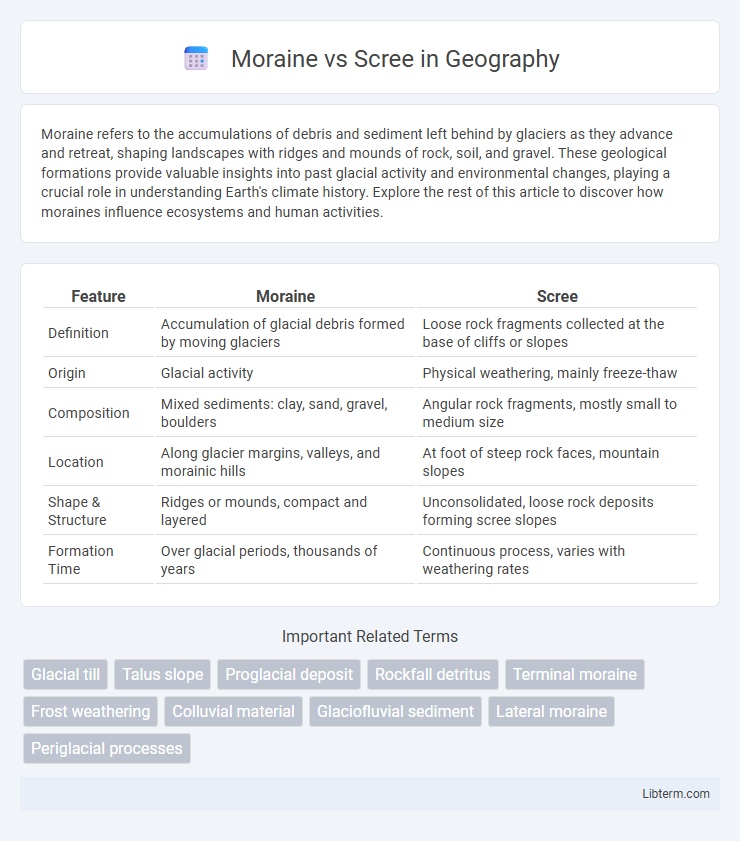Moraine refers to the accumulations of debris and sediment left behind by glaciers as they advance and retreat, shaping landscapes with ridges and mounds of rock, soil, and gravel. These geological formations provide valuable insights into past glacial activity and environmental changes, playing a crucial role in understanding Earth's climate history. Explore the rest of this article to discover how moraines influence ecosystems and human activities.
Table of Comparison
| Feature | Moraine | Scree |
|---|---|---|
| Definition | Accumulation of glacial debris formed by moving glaciers | Loose rock fragments collected at the base of cliffs or slopes |
| Origin | Glacial activity | Physical weathering, mainly freeze-thaw |
| Composition | Mixed sediments: clay, sand, gravel, boulders | Angular rock fragments, mostly small to medium size |
| Location | Along glacier margins, valleys, and morainic hills | At foot of steep rock faces, mountain slopes |
| Shape & Structure | Ridges or mounds, compact and layered | Unconsolidated, loose rock deposits forming scree slopes |
| Formation Time | Over glacial periods, thousands of years | Continuous process, varies with weathering rates |
Introduction to Moraine and Scree
Moraine and scree are distinct geological formations resulting from different types of glacial and erosional activity. Moraines consist of accumulated glacial debris, such as rocks and soil, deposited by moving glaciers, often forming ridges or mounds along glacier edges. Scree, also known as talus, is a collection of broken rock fragments that accumulate at the base of cliffs due to weathering and rockfall processes.
Definition of Moraine
Moraine refers to the accumulation of glacial debris, such as soil and rock, deposited directly by a glacier, forming distinct landforms like ridges or mounds. Unlike scree, which consists of loose rock fragments accumulated at the base of cliffs due to weathering and erosion, moraine materials are typically unsorted and include a mix of clay, sand, gravel, and boulders. Moraines are key indicators of past glacier movement and provide insights into glacial dynamics and climate history.
Definition of Scree
Scree refers to an accumulation of broken rock fragments at the base of cliffs or steep slopes, primarily composed of loose, angular debris formed by physical weathering processes such as freeze-thaw cycles. Unlike moraines, which consist of glacially transported till mixed with various particle sizes including clay, silt, sand, and boulders, scree is characterized by its unsorted, coarse, and fragmented nature. These talus slopes often play a crucial role in geomorphology by influencing slope stability and sediment transport in mountainous environments.
Formation Processes: Moraine vs Scree
Moraine forms through glacial activity, accumulating debris transported and deposited by moving ice, resulting in ridges or layers of unsorted sediment. Scree develops via mechanical weathering and freeze-thaw cycles, causing rock fragments to break off cliffs and accumulate as loose, angular debris at the base of slopes. Both processes reflect distinct environmental dynamics, with moraines indicating past glacial movement and scree highlighting active weathering in cold, mountainous regions.
Geological Composition Differences
Moraine consists primarily of unsorted glacial till made up of clay, silt, sand, gravel, and boulders deposited directly by glacier ice, often containing a mix of sharp and rounded rock fragments. Scree, also known as talus, is composed mainly of angular rock fragments that accumulate at the base of cliffs or steep slopes due to mechanical weathering processes like freeze-thaw cycles. The key geological difference lies in moraine's glacial origin and mixed sediment composition versus scree's weathering-derived, predominantly coarse, angular rock fragments.
Locations and Environments Found
Moraines are commonly found in glacial regions such as the Alps, Rockies, and Himalayas, where glaciers deposit accumulations of soil and rock debris. Scree typically occurs on steep mountain slopes and cliffs worldwide, formed from the physical weathering and fragmentation of rock faces. Moraines often indicate past or present glacial activity, whereas scree is characteristic of freeze-thaw cycles in alpine and arid environments.
Role in Landscape Evolution
Moraines serve as significant indicators of past glacial movement, shaping alpine and polar landscapes by depositing large accumulations of unsorted glacial debris that alter drainage patterns and create new landforms. Scree, formed by physical weathering processes such as freeze-thaw cycles, contributes to landscape evolution by gradually expanding talus slopes and influencing sediment distribution on mountain slopes. Both features play critical roles in geomorphic processes, with moraines indicating glacial dynamics and scree reflecting ongoing weathering and slope stability changes.
Ecological Impact and Biodiversity
Moraine deposits create diverse microhabitats that support specialized plant and animal species, enhancing local biodiversity through varied soil and moisture conditions. Scree slopes, characterized by unstable, loose rock fragments, generally host fewer species but provide critical refuges for certain pioneer plants and invertebrates adapted to harsh, dynamic environments. Both landforms influence ecological succession differently, with moraines fostering more stable ecosystems and scree promoting early colonization stages and unique niche habitats.
Human Relevance and Uses
Moraine and scree deposits play a significant role in human activities by shaping landscapes used for agriculture, construction, and tourism. Moraines, formed from glacial debris, provide fertile soils and create natural barriers beneficial for reservoirs and hiking trails. Scree slopes, composed of loose rock fragments, influence hazard assessments and land stability crucial for infrastructure development and outdoor recreation planning.
Summary: Key Differences Between Moraine and Scree
Moraine consists of accumulated glacial debris such as soil and rocks deposited directly by glacier movement, while scree refers to loose, angular rock fragments that have fallen and accumulated at the base of cliffs or slopes. Moraines typically form distinct ridges or mounds along glacier margins, whereas scree slopes appear as chaotic, unstable rock piles resulting from mechanical weathering. These geomorphological features differ mainly in origin, composition, and location relative to glacial activity.
Moraine Infographic

 libterm.com
libterm.com